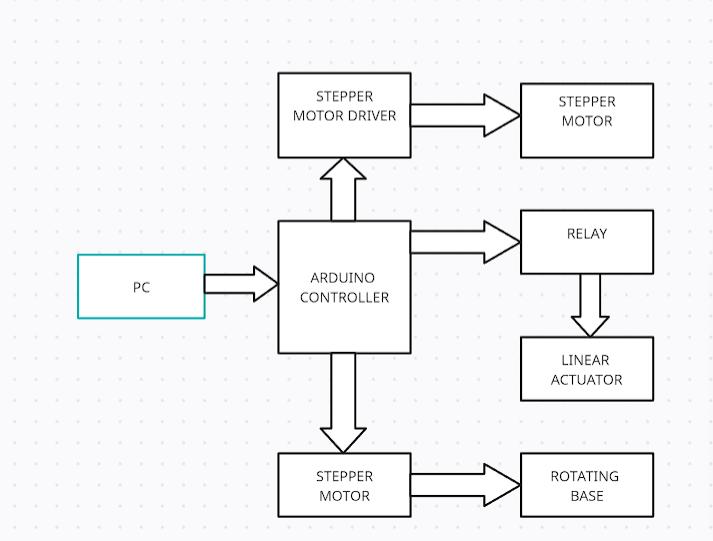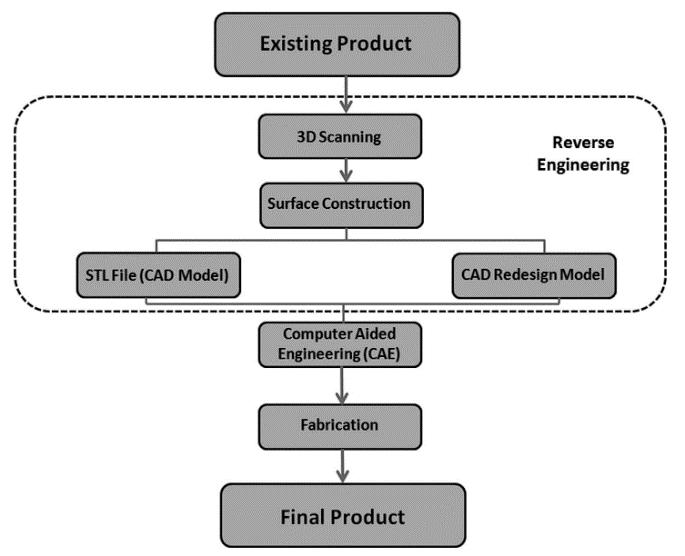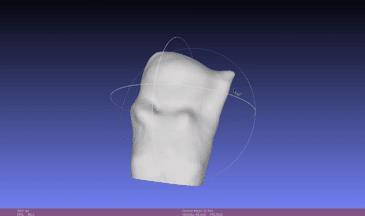
International Research Journal of Engineering and Technology (IRJET) e-ISSN: 2395-0056
Volume: 11 Issue: 03 | Mar 2024 www.irjet.net p-ISSN: 2395-0072
DESIGN AND FABRICATION OF METROLOGICAL 3D SCANNER
R.Mukundan1 , S.Jagan2 , S.Hariharan3 , R.Shanmugadasan4 , R.S.Prasanna Kumar 5
1Assistant Professor, Department of Mechatronics, Sri Manakula Vinayagar Engineering College, Puducherry, India
2,3,4,5U.G.Student, Department of Mechatronics, Sri Manakula Vinayagar Engineering College, Puducherry, India ***
Abstract - There have been several studies done to improve the technology of 3D scanning, like the source used to scan or the scanned 3D model, which undergoes several rectification procedures before being made into a complete error free model, but there are very few projects that automate the 3D scanning process. Here, we use the Arduino NANO along with a distance sensor to automate the 3D scanner on a small scale. This can be used in many industries to reduce the time consumed to re-design a product or to create a 3D model of an existing object. With this project, we can reduce or increase the time needed to scan based on the number of details needed.
Key Words: 3DScanning,Design,Pointcloud
1.INTRODUCTION
The current market for3D scanning in India is growing, with various types of 3D scanners on the market. But the only issue with them is that they require human labour, and their cost is high. This 3D scanner project uses an Arduino NANO and an IR distance sensor to digitalize physical objects.Itusestriangulationprinciplesandmesh software. The open-source nature and affordable components of the project exemplify innovation with purpose, demonstrating the potential of 3D scanning in theIndiancontext.
2. WORKING
The 3D scanner has a simple working mechanism that comprises an Arduino Nano, an IR distance sensor, an SD card module, and a stepper motor. The Arduino Nano is uploaded with the program, which is used to coordinate the hardware components in the 3D scanner. The stepper motor serves as the scanning mechanism, with the Arduino controlling the movement across the area of activity. The stepper motor movement is controlled by deliveringacertainpulsesequencethatcausesittorotate progressively. This enables fine angular control, allowing the scanner to collect detailed data about the object's surface geometry. The stepper motor is controlled by the Arduino to increase in small increments during the scanning process. The IR distance sensor gathers the information by reflecting on the form and contours of the item and measuring the distance between the sensor and theobject.
The data is recorded along with the stepper motor on the SD card, which is inserted in the SD card module. The scanning mechanism is performed well to get the objects precise distance measurements through the scanning region.ThemaincontrolunitoftheprojectistheArduino Nano, which directs the movement of the starter motor and organises the data collected on the SD card. The data iscollectedasa3Dpointcloud,whichisthenuploadedto themeshLABusingittoreconstructitasa3Dmodel.

3. METHODOLGY
Wefaceddifficultiesthroughoutourproject,especially in the sensor's calibration phase and the last steps of achieving the design. We had trouble during the sensor calibration stage since the sensor was positioned incorrectly,whichresultedinwarped3Dpointmodels.We verified the accuracy of our scanned data by contrasting thereconstructed3Dmodelwiththeactualobjectinorder to reduce such mistakes. We enhanced the scanning performance and fidelity by repeatedly adjusting the calibration and design settings, guaranteeing more accurateoutcomes.
The final design acquisition process was less of an issuewehadtodealwithhead-onandmoreofanapproach. Wewerenowfinishedwithalltherequiredsteps.However,

International Research Journal of Engineering and Technology (IRJET) e-ISSN: 2395-0056
Volume: 11 Issue: 03 | Mar 2024 www.irjet.net p-ISSN: 2395-0072
we were given the choice between two software programmes for turning the point cloud file into a 3D model: MATLAB and MeshLab. Compared to MATLAB, MeshLab has a more user-friendly interface and is opensource, which made it a better choice for our project's requirements. This choice allowed for more efficient data processing and workflow optimization, which eventually helpedusfinishour3Dscanningprojectsuccessfully.

3. HARDWARE
The hardware needed for this project is readily availableandreasonablypriced.Theopen-sourceArduino NANO controller, which is used in a variety of projects rangingfromentry-leveltohighlycomplex,istheoneused inthisproject.Thiscontrollerlevelallowsustocontrolup to 13 motors in a single direction and up to 6 motors in additiontodirectioncontrol.Next,weemployedtheNema 17fortheprimarymovingparts.Its3.2kgholdingtorque and1.8 degree minimumstepangleallow it to be used to improvepointcloudfileprecision,whichinturnimproves 3D model completion. The A4988 microstepping motor driver,whichisutilisedtooperatethemotoronestepata timefromuserinputpulses,hasbeenintegratedwithit.It is among the stepper motor's best-optimized motor drivers.
The source of the scanner is one of the project's main elements. An infrared 3D scanner is the one employedinthisproject.Itisutilisedsinceitisamongthe mostaffordableandhasa highdegree ofprecision, which improves the object's point cloud finishing. It operates on the triangulation principle, which uses trigonometry to pinpoint a fixed point's location given the knowledge of a triangle'stwoanglesandoneside.
Additionally, an SD card module is utilised to enable data store and retrieval operations by facilitating communication between an Arduino microcontroller and anSDcard.ItmakesuseoftheSPIprotocol,whichenables
quick data transfer between the SD card and Arduino. It functions as an external storage device that is utilised to save the point cloud straight out of the scanner, deliver it tothecomputer,andturnitintoaworkable3Dmodel.


4. SOFTWARE
We employed more recent software in the project. In order to create the 3D structural sections that needed to be more accurate at the beginning of the project, we utilized CAD software. In particular, we selected Fusion 360 software because of its many benefits, which include integrated workflow, cloud-based collaboration, simulation,andanalysis.Allthingsconsidered,Fusion360 offersastrongandadaptableproductdesign,engineering, andmanufacturingsolutionthatenablesuserstodevelop, worktogether,andsuccessfullyrealizetheirideas.
We employed more recent software in the project. In order to create the 3D structural sections that needed to be more accurate at the beginning of the project, we utilized CAD software. In particular, we selected Fusion 360 software because of its many benefits, which include integrated workflow, cloud-based collaboration, simulation,andanalysis.Allthingsconsidered,Fusion360 offersastrongandadaptableproductdesign,engineering, andmanufacturingsolutionthatenablesuserstodevelop, worktogether,andsuccessfullyrealizetheirideas.

International Research Journal of Engineering and Technology (IRJET) e-ISSN: 2395-0056
Volume: 11 Issue: 03 | Mar 2024 www.irjet.net p-ISSN: 2395-0072
Additionally, we programmed the microcontroller utilized in the project using the Arduino IDE as it offers a flexible and easy-to-use platform for programming Arduino boards, allowing programmers of all experience levels to develop interactive projects and prototypes. Electronicsamateursand expertsalikefavor it because of itsopen-sourcenature,easeofuse,andsimplicity.
Finally, we utilize software to scan the output and create a 3D model for the project. Generally speaking, there are other programs like Leica Cyclone, Point Cloud Processing Software, ESRI ArcGIS, QGIS, Autodesk AutoCADMap3D,GlobalMapper,FAROSCENE,andmore. We choose to utilize meshlab software since it is a portable, adaptable, open-source platform for handling andmodifyingunstructured3Dtrianglemeshes.Itoffersa large selection of tools for 3D mesh model processing, cleaning, editing, and rendering. In summary, MeshLab is an effective and multipurpose tool that can be used for a variety of 3D modeling and visualization tasks. It has an extensivefeatureset.Intherealmofdigital3Dprocessing and editing, its open-source design, cross-platform compatibility, and vibrant community render it an invaluabletool.


5. CONCLUSION
To sum up, the creation of an automated 3D scanner with an IR distance sensor and an Arduino NANO is a majoradvancementinthefieldof3Dscanningtechnology. With the addition of automation, affordability, and adaptability, this idea overcomes the drawbacks of the current3Dscanningtechniques.Thisprojectshowsthata practical and affordable 3D scanning solution can be created by integrating widely accessible and moderately priced hardware components, such as the IR distance sensor, Nema 17 stepper motor, and Arduino NANO controller. Accessibility and versatility are further improved by the use of open-source software tools, such as MeshLab for mesh processing and the Arduino IDE for programming. In order to guarantee precise and dependable scanning findings, the project's methodology included iterative calibration and optimization procedures. Careful testing and parameter adjustments allowed us to overcome obstacles that arose during the sensorcalibrationprocessandthefinaldesignacquisition.
Overall, this project's automated 3D scanner offers a practical, affordable, and approachable way to digitize actualthingsandproduceprecise3Dmodels.Itisamajor leap in 3D scanning technology. As this technology is furtherdevelopedandoptimized,ithasthepotentialtobe widely used and integrated into a wide range of applications, which will improve the field of digital 3D processingandediting.
REFERENCES
[1] Alaa Abd-Raheem, Farah AlDeiri and Musa Alyaman "DesignofanAutomated3DScanner"-IEEE,2018.
[2] Yao, A.W.L., Applications of 3D scanning and reverse engineering techniques for quality control of quick response products. The International Journal of AdvancedManufacturingTechnology,2005.
[3] Pawar, S.S., et al. Review paper on design of 3D scanner. in 2017 International Conference on Innovative Mechanisms for Industry Applications (ICIMIA).2017.
[4] CHEN, Z., Robust reconstruction of textured surfaces from3DPointClouds.2013.
[5] Exploringthepotentialof3DscanninginIndustry4.0International Journal of Cognitive Computing in Engineering,2022.
[6] Design and Analysis of 3D Scanning System for ScanninganObject-IJERT,2020.
[7] 3D scanning applications in medical field- Clinical EpidemiologyandGlobalHealth,2019.

International Research Journal of Engineering and Technology (IRJET) e-ISSN: 2395-0056
Volume: 11 Issue: 03 | Mar 2024 www.irjet.net p-ISSN: 2395-0072
[8] APPLYING SCANNING TECHNIQUES TO CREATE 3D MODEL-IEEE,2015.
[9] Application of a 3D Scanner in Robotic Measurement ofAviationComponent-MDPI,2022.
[10] Characterization of a Large, Low-Cost 3D ScannerMDPI,2015.
2024, IRJET | Impact Factor value: 8.226 | ISO 9001:2008
